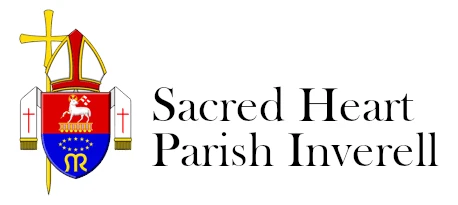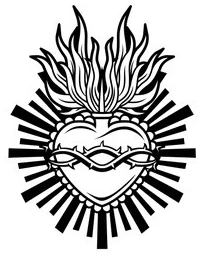Feast Day of Our Lady of Sorrows - 15 September 2024
15th September 2024

"Let us bind ourselves tightly to the Sorrowful Heart of our Heavenly Mother and reflect on its boundless grief and how precious is our soul." - St Padre Pio
A reflection on Our Blessed Mother Mary as Our Lady of Sorrows by the Venerable Archbishop Fulton J Sheen in his acclaimed book The Word's First Love:
"Tradition indicates that Mary was pierced seven times with swords of sorrow and that these constitute her Seven Dolors. The position we will take is not that there were seven swords, but seven thrusts of the one sword, and the sword that pierced her soul was Christ Himself. This Sword has a double edge: one edge ran into His Own Sacred Heart, the other into her Immaculate Heart. How is Christ a sword? First of all, the Epistle to the Hebrews tells us the word of God is a two-edged sword: 'God's word to us is something alive, full of energy; it can penetrate deeper than any two-edged sword, reaching the very division between soul and spirit, between joints and marrow, quick to distinguish every thought and design in our hearts. From Him, no creature can be hidden; everything lies bare, everything is brought face to face with Him, this God to Whom we must give our account' (Heb 4:12, 13). The 'word' here is undoubtedly Scripture and the living voice of the Church. But the root, the source is the Divine Word, Who is Christ Himself. St. Thomas in his Commentary on this passage makes that identification. Furthermore, St. Thomas quotes St. Ambrose as giving the same interpretation: 'For the Word of God is living and effectual and more piercing than any two-edged sword.'
"One edge of this sword — to speak metaphorically — Christ ran into His Own Sacred Heart, in the sense that He willed all the sufferings from Bethlehem to Calvary. He was the cause of His own death, St. Thomas tells us, and in two ways: directly, by being in such antagonism to the world that the world could not endure His Presence. Simeon foretold this by saying He was 'a sign to be contradicted.' The essence of evil is not robbing, stealing, murdering; it is the crucifixion of Goodness, the elimination of the Moral Principle of life, so that one may sin without remorse and with impunity. Indirectly, Christ was the cause of His Own death, as St. Thomas tells us, 'by not preventing it when He could do so; just as one person is said to drench another by not closing the window through which it is raining; and in this way Christ was the cause of His Own Passion and Death.' He could have used His Power and hurled thunderbolts against Pilate and Herod; He could have appealed to the masses with the magnetism of His Word; He could have changed nails into rosebuds and a crown of thorns into a golden diadem; He could have come down from the Cross when He was challenged to do so. But 'since Christ's soul did not repel the injury inflicted on His body, but willed His corporeal nature to succumb to such an injury, He is said to have laid down His life or died voluntarily,' St. Thomas tells us.
"The Sword, therefore, was His Own will to die, that we might be saved from the double death. But He also willed that His Mother should be as closely associated with Him as any human person could be associated with a Divine Person. Pius X declared that the bond between them was so intimate that the words of the Prophet could be applied to both: Defecit in dolore vita mea, et anni mei in gemitibus (Ps 31:11). If it be granted with Leo XIII that 'God willed that the grace and truth which Christ won for us should be bestowed on us in no other way than through Mary,' then she, too, had to will cooperation in redemption, as Christ willed it as the Redeemer Himself. Christ willed that she should suffer with Him, some theologians say, per modum unius. If He willed His death, He willed her Dolors. And if He willed to be a 'Man of Sorrows,' He willed that she be the 'Mother of Sorrows.' But it was no imposed will; she accepted it all in her original Fiat in the Annunciation. The Sword He plunged into His Heart, He, with her cooperation, plunged into her own. He could hardly have done this if she were not His Mother and if they were not in a spiritual sense 'two in one flesh,' 'two in one mind.' The sorrows of His Passion were His, but His Mother considered them her own, too, for this is the meaning of compassion.
"There were not seven swords but only one, and it plunged into two hearts. The Seven Dolors are as seven thrusts of the Sword Christ, one edge for Him as Redeemer, the other edge for her as the Mother of the Redeemer. Christ is the Sword of His Own Passion; He is the Sword of her compassion. Pius XII says that she, as the true Queen of Martyrs, more than any of the faithful, filled up for His Body the Church the sufferings that were wanting to the Passion of Christ!
"This was the first reason why God permitted her Dolors, that she might be the first after the Redeemer Himself to continue His Passion and death in His Mystical Body. Our Lord warned: 'As they hated Me, so will they hate you.' If the law that Good Friday is the condition of an Easter Sunday binds all the faithful, then it must with greater rigor bind her who is the Mother of the Saviour. An unsuffering Christ Who ignored sin would be reduced to the level of an ethical reformer, like Buddha or Confucius. An unsuffering Madonna to the suffering Christ would be a loveless Madonna. Who is there who loves, who does not want to share the sorrows of the beloved? Since Christ loved mankind so much as to want to die to expiate their guilt, then He should also will that His Mother, who lived only to do His will, should also be wrapped in the swaddling bands of His griefs.
"But she also had to suffer for our sakes as well as for His. As Our Lord learned obedience by which He suffered, so Mary had to learn motherhood, not by appointment but by experience with the burdens of the human heart. The rich cannot console the poor unless they become less rich for the sake of the poor; Mary cannot wipe away human tears unless she herself has been their fountain. The title 'Mother of the Afflicted' had to be earned in the school of affliction. She does not expiate for sins; she does not redeem; she is not a saviour — but by His will and by her own, she is so much bound up with Him that His Passion would have been entirely different had there not been her compassion.
"He also plunged the sword into her own soul in the sense that He called her to be a co-operator with Him, as the new Eve, in the regeneration of humanity. When the mother of James and John asked political preferment for her sons, they were asked if they could drink of His chalice. That was the condition of being in His Kingdom. What draining of the chalice, then, shall be the condition of being the Mother of the Crucified! St. Paul tells us that we cannot be partakers of His glory unless we partake also of His crucifixion. If, then, the sons of Mary are not exempt from the law of sacrifice, certainly Mary herself, who is the Mother of God, shall be less exempt. Hence Stabat Mater pleads that Mary's compassion with Christ be shared with us:
'These five wounds of Jesus smitten,
Mother in my heart be written
Deeply as in thine they be;
Thou my Saviour's Cross who bearest
Thou thy Son's rebuke who sharest,
Let me share them both with thee.'"
Prayer to Our Lady of Sorrows
O Mary, Mother of Love, Mother of Sorrows and Mother of Mercy! We beg you, whose heart was pierced seven times in sorrow, to unite your petition with ours so that your Divine Son, Jesus, to Whom we now turn in the name of your Mother Tears, answers our prayers and, with the graces we ask for, grants us the kingdom of eternal life. Amen. 🙏💖💐


